
Eleanor cross
Encyclopedia
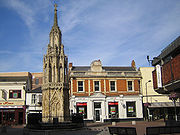
The Eleanor crosses were twelve originally wooden, but later lavishly decorated stone, monuments of which three survive intact in a line down part of the east of England
England
England is a country that is part of the United Kingdom. It shares land borders with Scotland to the north and Wales to the west; the Irish Sea is to the north west, the Celtic Sea to the south west, with the North Sea to the east and the English Channel to the south separating it from continental...
. King Edward I
Edward I of England
Edward I , also known as Edward Longshanks and the Hammer of the Scots, was King of England from 1272 to 1307. The first son of Henry III, Edward was involved early in the political intrigues of his father's reign, which included an outright rebellion by the English barons...
had the crosses erected between 1291 and 1294 in memory of his wife Eleanor of Castile
Eleanor of Castile
Eleanor of Castile was the first queen consort of Edward I of England. She was also Countess of Ponthieu in her own right from 1279 until her death in 1290, succeeding her mother and ruling together with her husband.-Birth:...
, marking the nightly resting-places along the route taken when her body was transported to London. Several artists worked on the crosses, as the "Expense Rolls" of the Crown show, with some of the work being divided between the main figures, sent from London, and the framework, made locally. William of Ireland was apparently the leading sculptor of figures.
The procession
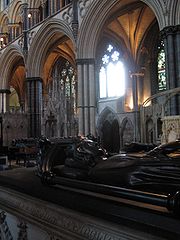
Upon her death in 1290 at Harby
Harby, Nottinghamshire
Harby is a village in the English county of Nottinghamshire, the farthest eastern village within the county boundaries. The nearest large town is Lincoln over the border in Lincolnshire. According to the 2001 census it had a population of 289. The parish church of All Saints was built in 1875-76 in...
, near the city of Lincoln
Lincoln, Lincolnshire
Lincoln is a cathedral city and county town of Lincolnshire, England.The non-metropolitan district of Lincoln has a population of 85,595; the 2001 census gave the entire area of Lincoln a population of 120,779....
, the body of Queen Eleanor was carried to the Gilbertine priory of St. Catherine, Lincoln in the south of Lincoln, where she was embalmed. Her viscera
Viscus
In anatomy, a viscus is an internal organ, and viscera is the plural form. The viscera, when removed from a butchered animal, are known collectively as offal...
were sent for burial in the Angel Choir of Lincoln Cathedral
Lincoln Cathedral
Lincoln Cathedral is a historic Anglican cathedral in Lincoln in England and seat of the Bishop of Lincoln in the Church of England. It was reputedly the tallest building in the world for 249 years . The central spire collapsed in 1549 and was not rebuilt...
, where they still rest. Her body was then sent to London
London
London is the capital city of :England and the :United Kingdom, the largest metropolitan area in the United Kingdom, and the largest urban zone in the European Union by most measures. Located on the River Thames, London has been a major settlement for two millennia, its history going back to its...
, taking 12 days to reach Westminster Abbey
Westminster Abbey
The Collegiate Church of St Peter at Westminster, popularly known as Westminster Abbey, is a large, mainly Gothic church, in the City of Westminster, London, United Kingdom, located just to the west of the Palace of Westminster. It is the traditional place of coronation and burial site for English,...
. The crosses were erected at the places where her funeral procession stopped overnight.
At Westminster she was buried at the feet of her father-in-law King Henry III
Henry III of England
Henry III was the son and successor of John as King of England, reigning for 56 years from 1216 until his death. His contemporaries knew him as Henry of Winchester. He was the first child king in England since the reign of Æthelred the Unready...
. Her heart travelled with the body and was buried in the abbey church at Blackfriars.
Reasons for construction
A similar event had taken place in France for the body of King Louis IXLouis IX of France
Louis IX , commonly Saint Louis, was King of France from 1226 until his death. He was also styled Louis II, Count of Artois from 1226 to 1237. Born at Poissy, near Paris, he was an eighth-generation descendant of Hugh Capet, and thus a member of the House of Capet, and the son of Louis VIII and...
in 1271 (although his were as a manifesto for canonization
Canonization
Canonization is the act by which a Christian church declares a deceased person to be a saint, upon which declaration the person is included in the canon, or list, of recognized saints. Originally, individuals were recognized as saints without any formal process...
, unlike in Eleanor's case) and Edward had probably seen similar memorial crosses in France and elsewhere in Europe during his travels. They were at least in part intended as cenotaph
Cenotaph
A cenotaph is an "empty tomb" or a monument erected in honour of a person or group of people whose remains are elsewhere. It can also be the initial tomb for a person who has since been interred elsewhere. The word derives from the Greek κενοτάφιον = kenotaphion...
s to provoke prayers for her soul from passers-by and pilgrims
The twelve places
The only three crosses still standing are those at Waltham Cross, at Hardingstone in Northamptonshire, and at Geddington, although remnants of the lost ones can also be seen.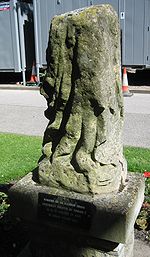
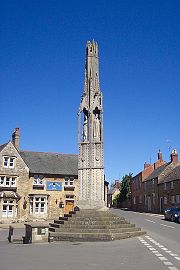
LincolnLincoln, LincolnshireLincoln is a cathedral city and county town of Lincolnshire, England.The non-metropolitan district of Lincoln has a population of 85,595; the 2001 census gave the entire area of Lincoln a population of 120,779....
(53°12′51"N 00°32′47"W)The only remaining piece of the St Catherine's cross is in Lincoln Castle
Lincoln Castle
Lincoln Castle is a major castle constructed in Lincoln, England during the late 11th century by William the Conqueror on the site of a pre-existing Roman fortress. The castle is unusual in that it has two mottes. It is only one of two such castles in the country, the other being at Lewes in Sussex...
.
StamfordStamford, LincolnshireStamford is a town and civil parish within the South Kesteven district of the county of Lincolnshire, England. It is approximately to the north of London, on the east side of the A1 road to York and Edinburgh and on the River Welland...
(52°39′22"N 00°29′37"W)Only a small marble fragment, a carved rose excavated by William Stukeley
William Stukeley
William Stukeley FRS, FRCP, FSA was an English antiquarian who pioneered the archaeological investigation of the prehistoric monuments of Stonehenge and Avebury, work for which he has been remembered as "probably... the most important of the early forerunners of the discipline of archaeology"...
, survives which is currently preserved in Stamford Museum
Stamford Museum
Stamford Museum was located in Stamford, Lincolnshire in Great Britain. It was housed in a Victorian building in Broad Street, Stamford and was run by the museum services of Lincolnshire County Council from 1980 to 2011.-The building and area:...
.
See below for the modern monument.
GeddingtonGeddingtonGeddington is a village and civil parish on the A43 in north-east Northamptonshire between Kettering and Corby.It contains what is thought to be the best surviving Eleanor cross. The monument dates from 1294, when the crosses were raised as a memorial by Edward I to his late wife, Eleanor of...
(52°26′15"N 00°41′07"W)Still standing, it is said to be the best-preserved of the three survivors. It is unique among the surviving crosses in having a triangular plan, and a taller and more slender profile with a lower tier entirely covered with diapering
Diapering
Diaper is any of a wide range of decorative patterns used in a variety of works of art, such as stained glass, heraldic shields, architecture, silverwork etc. Its chief use is in the enlivening of plain surfaces.-Etymology:...
, instead of the arch-and-gable motif with tracery which appears on both the others; and canopied statues surmounted by a slender hexagonal pinnacle.

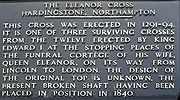
HardingstoneHardingstoneHardingstone is a village in Northamptonshire, England. It is on the southern edge of Northampton, and now forms a suburb of the town within the Northampton Borough Council area. It is about from the town centre...
, NorthamptonNorthamptonNorthampton is a large market town and local government district in the East Midlands region of England. Situated about north-west of London and around south-east of Birmingham, Northampton lies on the River Nene and is the county town of Northamptonshire. The demonym of Northampton is...
(52°13′02"N 00°53′50"W)The Northampton cross is still standing at the edge of Delapré Abbey
Delapré Abbey
Delapré Abbey , or more properly, the Convent of St Mary De La Pré, was founded as a Cluniac nunnery about the year 1145, situated in the meadows of the River Nene to the south of Northampton ....
; the King stayed at nearby Northampton Castle. This cross was begun in 1291 by John of Battle. He worked with William of Ireland to carve the statues: William was paid £3 6s. 8d. per figure.
The cross is octagonal in shape and set upon some steps - the present ones are replacements. It is built in three tiers and originally had a crowning terminal - possibly a cross. It is not known when this became lost. A local anecdote says that it was knocked off by a low flying aircraft from a nearby airfield in WWII.
The Cross is referred to in Daniel Defoe
Daniel Defoe
Daniel Defoe , born Daniel Foe, was an English trader, writer, journalist, and pamphleteer, who gained fame for his novel Robinson Crusoe. Defoe is notable for being one of the earliest proponents of the novel, as he helped to popularise the form in Britain and along with others such as Richardson,...
's a "Tour through the whole island of Great Britain
A tour thro' the Whole Island of Great Britain
A tour thro' the whole island of Great Britain is an account of his travels by English author Daniel Defoe, first published in three volumes between 1724 and 1727....
", where he reports on the Great Fire of Northampton in 1675, "...a townsman being at Queen's Cross upon a hill on the south side of the town, about two miles off, saw the fire at one end of the town then newly begun, and that before he could get to the town it was burning at the remotest end, opposite where he first saw it."
Its bottom tier features open books. These probably included painted inscriptions of her biography and of prayers for her soul to be said by viewers, now lost.
Stony StratfordStony StratfordStony Stratford is a constituent town of Milton Keynes and is a civil parish with a town council within the Borough of Milton Keynes. It is in the north west corner of Milton Keynes, bordering Northamptonshire and separated from it by the River Great Ouse...
(plaque at 52°03′32"N 00°51′24"W)This cross stood at the lower end of the town, towards the river Ouse
River Great Ouse
The Great Ouse is a river in the east of England. At long, it is the fourth-longest river in the United Kingdom. The river has been important for navigation, and for draining the low-lying region through which it flows. Its course has been modified several times, with the first recorded being in...
, on Watling Street
Watling Street
Watling Street is the name given to an ancient trackway in England and Wales that was first used by the Britons mainly between the modern cities of Canterbury and St Albans. The Romans later paved the route, part of which is identified on the Antonine Itinerary as Iter III: "Item a Londinio ad...
(now the High Street), although its exact location is hotly debated. It is said to have been of a tall elegant design (perhaps similar to that at Geddington) but was destroyed during the Civil War
English Civil War
The English Civil War was a series of armed conflicts and political machinations between Parliamentarians and Royalists...
by the Parliamentarians. The base survived for some time, but any trace has vanished. This commemorative plaque on the wall of 157 High Street is all that is now visible:
- Near this spot stood the Cross erected by King Edward the I to mark the place in Stony Stratford where the body of Queen Eleanor rested on its way from Harby in Nottinghamshire to Westminster Abbey in 1290
WoburnWoburn, BedfordshireWoburn is a small Saxon village and civil parish in Bedfordshire, England. It is situated about southeast of the centre of Milton Keynes, and about south of junction 13 of the M1 motorway and is a popular tourist attraction.-History:...
(approximately at 51°59′20"N 00°37′10"W)Work on the cross started in 1292, later than most of the others. A great part of the work was done by Ralph de Chichester. No part survives. The precise location is unknown.
Dunstable
(51°53′10"N 00°31′16"W)Eleanor's coffin was guarded by Canons in the Dunstable Priory
Dunstable Priory
The Priory Church of St Peter with its monastery was founded in 1132 by Henry I for Augustinian Canons in Dunstable, Bedfordshire, England. St Peter’s today is a large and impressive building, but this is only the nave of what remains of an originally much larger Augustinian priory church...
whilst local people mourned at the cross roads, the location where the original cross was then constructed. A shopping precinct in High Street North now contains a modern cross statue in her honour.
St AlbansSt AlbansSt Albans is a city in southern Hertfordshire, England, around north of central London, which forms the main urban area of the City and District of St Albans. It is a historic market town, and is now a sought-after dormitory town within the London commuter belt...
(51°45′04"N 00°20′26"W)A cross was erected at a cost of £100 in the Market Place. It stood for many years in front of the fifteenth century Clock Tower in the High Street (opposite the Waxhouse Gateway entrance to the Abbey
St Albans Cathedral
St Albans Cathedral is a Church of England cathedral church at St Albans, England. At , its nave is the longest of any cathedral in England...
), and was demolished in the early eighteenth century due to neglect, and replaced by the town pump. A fountain was erected in its stead in 1874, which was subsequently relocated to Victoria Place.
Waltham (now Waltham CrossWaltham CrossWaltham Cross is the most southeasterly town in Hertfordshire, England. It is 12 miles from the City of London and immediately north of the M25 motorway, forming part of the Greater London Urban Area and London commuter belt. Part of Waltham Cross is located within Greater London.-Geography:It is...
)
(51°41′09"N 00°01′59"W)Still standing, although restored many times, but its original statues of Eleanor were replaced by replicas during the last major restoration in the 1950s. For many years the original statues stood at Cheshunt Public Library; but they were removed, possibly in the 1980s, to the Victoria & Albert Museum. A photograph on the Lowewood Museum website shows one of the original statues in front of a staircase at this library. The original monument was constructed in co-operation between an architect and a sculptor: Roger of Crundale, who was the senior royal mason, and Master Alexander of Abingdon, respectively.
Westcheap (now CheapsideCheapsideCheapside is a street in the City of London that links Newgate Street with the junction of Queen Victoria Street and Mansion House Street. To the east is Mansion House, the Bank of England, and the major road junction above Bank tube station. To the west is St. Paul's Cathedral, St...
)
(51°30′51"N 00°05′41"W)Fragments are held by the Museum of London
Museum of London
The Museum of London documents the history of London from the Prehistoric to the present day. The museum is located close to the Barbican Centre, as part of the striking Barbican complex of buildings created in the 1960s and 70s as an innovative approach to re-development within a bomb damaged...
, and surviving drawings enable an accurate reconstruction to be established.
The Cheapside Cross was demolished in May 1643 under an ordinance from the parliamentary Committee for the Demolition of Monuments of Superstition and Idolatry, led by Sir Robert Harley. The cross was the third incarnation of the monument, which had been reconstructed and refurbished several times in the preceding three centuries, in which time it had enjoyed the protection of various monarchs and the Mayor and Corporation of London.
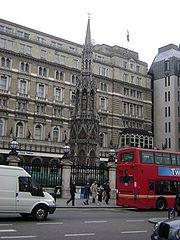
After Charles I had fled London to raise an army at the start of the Civil War, the destruction of the cross was almost the first order of business for Harley's commission. Though less well known than the Charing Cross, the downfall of the Cheapside Cross is one of the most interesting and arguably important examples of iconoclasm in English history.
Charing (now Charing CrossCharing CrossCharing Cross denotes the junction of Strand, Whitehall and Cockspur Street, just south of Trafalgar Square in central London, England. It is named after the now demolished Eleanor cross that stood there, in what was once the hamlet of Charing. The site of the cross is now occupied by an equestrian...
)
(51°30′26"N 00°07′39"W)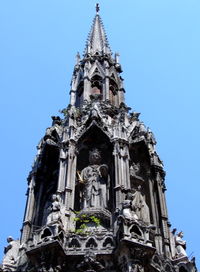
Royal Mews
A Royal Mews is a mews of the British Royal Family. In London the Royal Mews has occupied two main sites, formerly at Charing Cross, and since the 1820s at Buckingham Palace....
, was the most expensive, built of marble in cooperation between an architect, Richard of Crundale, who was the senior royal mason, and a sculptor, Master Alexander of Abingdon.
Charing is the subject of the romantic etymology
Etymology
Etymology is the study of the history of words, their origins, and how their form and meaning have changed over time.For languages with a long written history, etymologists make use of texts in these languages and texts about the languages to gather knowledge about how words were used during...
of chère reine (dear queen), but the name "Charing" was certainly used in the contemporary royal accounting records for the costs of constructing the cross. The name Charing probably comes from the Anglo-Saxon word cerring, a bend, as it stands on the outside of a 90-degree bend in the River Thames (see Charing
Charing
Charing is a small village and civil parish in the Ashford District of Kent, in south-east England. The parish population is 2,750 ; it includes the settlement of Charing Heath.It is situated at the foot of the North Downs...
in Kent). The original cross stood at the top of Whitehall
Whitehall
Whitehall is a road in Westminster, in London, England. It is the main artery running north from Parliament Square, towards Charing Cross at the southern end of Trafalgar Square...
on the south side of Trafalgar Square
Trafalgar Square
Trafalgar Square is a public space and tourist attraction in central London, England, United Kingdom. At its centre is Nelson's Column, which is guarded by four lion statues at its base. There are a number of statues and sculptures in the square, with one plinth displaying changing pieces of...
, but was destroyed on the orders of Parliament in 1647 during the Civil War
English Civil War
The English Civil War was a series of armed conflicts and political machinations between Parliamentarians and Royalists...
, and was replaced by an equestrian statue of Charles I
Charles I of England
Charles I was King of England, King of Scotland, and King of Ireland from 27 March 1625 until his execution in 1649. Charles engaged in a struggle for power with the Parliament of England, attempting to obtain royal revenue whilst Parliament sought to curb his Royal prerogative which Charles...
in 1675 following the Restoration
Restoration (1660)
The term Restoration in reference to the year 1660 refers to the restoration of Charles II to his realms across the British Empire at that time.-England:...
. This point in Trafalgar Square is regarded as the official centre of London in legislation and when measuring distances from London.
A replacement cross was erected in 1865 in front of Charing Cross railway station
Charing Cross railway station
Charing Cross railway station, also known as London Charing Cross, is a central London railway terminus in the City of Westminster, England. It is one of 18 stations managed by Network Rail, and trains serving it are operated by Southeastern...
, a few hundred yards to the east along the Strand
Strand, London
Strand is a street in the City of Westminster, London, England. The street is just over three-quarters of a mile long. It currently starts at Trafalgar Square and runs east to join Fleet Street at Temple Bar, which marks the boundary of the City of London at this point, though its historical length...
. It is not a faithful replica, being more ornate than the original. It stands 70 ft (21.3 m) high and was commissioned by the South Eastern Railway
South Eastern Railway (UK)
The South Eastern Railway was a railway company in south-eastern England from 1836 until 1922. The company was formed to construct a route from London to Dover. Branch lines were later opened to Tunbridge Wells, Hastings, Canterbury and other places in Kent...
Company for their newly-opened Charing Cross Hotel. The new cross was designed by the architect of the hotel, E.M.Barry
Edward Middleton Barry
Edward Middleton Barry was an English architect of the 19th century.-Biography:Edward Barry was the third son of Sir Charles Barry, born in his father's house, 27 Foley Place, London. In infancy he was delicate, and was placed under the care of a confidential servant at Blackheath...
, who is best known for his work on Covent Garden
Covent Garden
Covent Garden is a district in London on the eastern fringes of the West End, between St. Martin's Lane and Drury Lane. It is associated with the former fruit and vegetable market in the central square, now a popular shopping and tourist site, and the Royal Opera House, which is also known as...
. It was constructed by Thomas Earp
Thomas Earp
Thomas Earp was an English Liberal Party politician who sat in the House of Commons from 1874 to 1885.Earp was the son of William Earp of Derby and his wife Sarah Taylor, daughter of James Taylor of Muskham. He was educated at the Diocesan School in Derby and became a partner in the firms of...
of Lambeth from Portland stone
Portland stone
Portland stone is a limestone from the Tithonian stage of the Jurassic period quarried on the Isle of Portland, Dorset. The quarries consist of beds of white-grey limestone separated by chert beds. It has been used extensively as a building stone throughout the British Isles, notably in major...
, Mansfield
Mansfield
Mansfield is a town in Nottinghamshire, England. It is the main town in the Mansfield local government district. Mansfield is a part of the Mansfield Urban Area....
stone (a fine sandstone) and Aberdeen granite. It was restored to a substantial extent between October 2009 and July 2010.
Fragments of the medieval structure are held in the Museum of London
Museum of London
The Museum of London documents the history of London from the Prehistoric to the present day. The museum is located close to the Barbican Centre, as part of the striking Barbican complex of buildings created in the 1960s and 70s as an innovative approach to re-development within a bomb damaged...
and surviving drawings of the original enable an accurate virtual reconstruction.
Replicas and imitations
During the nineteenth and early twentieth centuries several replica Eleanor Crosses were erected, including at IlamIlam, Staffordshire
Ilam is a village in the Staffordshire Peak District, lying on the River Manifold. This article describes some of the main features of the village and surroundings.- Ilam village :...
in Staffordshire
Staffordshire
Staffordshire is a landlocked county in the West Midlands region of England. For Eurostat purposes, the county is a NUTS 3 region and is one of four counties or unitary districts that comprise the "Shropshire and Staffordshire" NUTS 2 region. Part of the National Forest lies within its borders...
, Walkden
Walkden
Walkden is a town within the metropolitan borough of the City of Salford, in Greater Manchester, England. It is west-northwest of Salford, and west-northwest of Manchester....
in Lancashire
Lancashire
Lancashire is a non-metropolitan county of historic origin in the North West of England. It takes its name from the city of Lancaster, and is sometimes known as the County of Lancaster. Although Lancaster is still considered to be the county town, Lancashire County Council is based in Preston...
, Sledmere in the East Riding
Sledmere
Sledmere is a village in the East Riding of Yorkshire, England that is situated approximately north west of Driffield on the B1253 road.Together with the hamlet of Croome it forms the civil parish of Sledmere and Croome....
of Yorkshire, and at Queensbury, London
Queensbury, London
Queensbury is a locality in northwest London, England. It is located in the south eastern part of the London Borough of Harrow and on the boundary with the London Borough of Brent.-Geography and history:...
.
The Ilam cross was built in 1840 by Jesse Watts Russell of Ilam Hall to commemorate his wife.
The Market Cross
Market cross
A market cross is a structure used to mark a market square in market towns, originally from the distinctive tradition in Early Medieval Insular art of free-standing stone standing or high crosses, often elaborately carved, which goes back to the 7th century. Market crosses can be found in most...
in Glastonbury
Glastonbury
Glastonbury is a small town in Somerset, England, situated at a dry point on the low lying Somerset Levels, south of Bristol. The town, which is in the Mendip district, had a population of 8,784 in the 2001 census...
resembles an Eleanor cross.
The start of the 21st Century was marked in Stamford by erecting a modern monument inspired by the lost Cross. It stands in Sheepmarket, rather than at the original location. The carved detail is based on the fragment in Stamford Museum.

